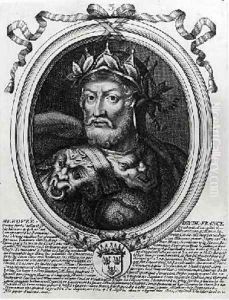Nicolas II de Larmessin Paintings
Nicolas II de Larmessin was a French engraver, born into a family of artists and printmakers in 1632 in Paris, France. He was part of the Larmessin family, which included several generations of engravers and publishers, making significant contributions to the world of printmaking during the 17th and 18th centuries. Nicolas II is particularly remembered for his role in continuing the family tradition, working extensively on portraits, religious subjects, and especially for his series of 'Costumes Grotesques'.
The 'Costumes Grotesques' are perhaps what Nicolas II de Larmessin is best known for. This series of prints depicted people wearing clothes made of various objects and tools related to their professions or the roles they played within society. These imaginative and often humorous engravings served as a form of social commentary, reflecting on the professions and societal roles of the time. The detailed and whimsical nature of these prints has captured the imagination of audiences both in his time and in modern analyses of early modern European art.
Aside from his famous series, Larmessin also contributed to the family’s publishing business, producing portraits and religious works that were characteristic of the period’s engraving styles. His works were part of the larger Baroque movement, which was known for its detailed and elaborate artistry, both of which are evident in Larmessin's engravings. Despite the fame of the 'Costumes Grotesques', much of his other work also demonstrates a high level of skill and creativity, contributing to his reputation as a respected engraver of his time.
Nicolas II de Larmessin passed away in 1694, leaving behind a legacy that has been somewhat overshadowed by other artists of the era but remains a fascinating study for art historians interested in printmaking and the Baroque period. His contributions to the art of engraving and his unique approach to illustrating the social fabric of his time through the 'Costumes Grotesques' series continue to be appreciated for their artistic and historical value.
